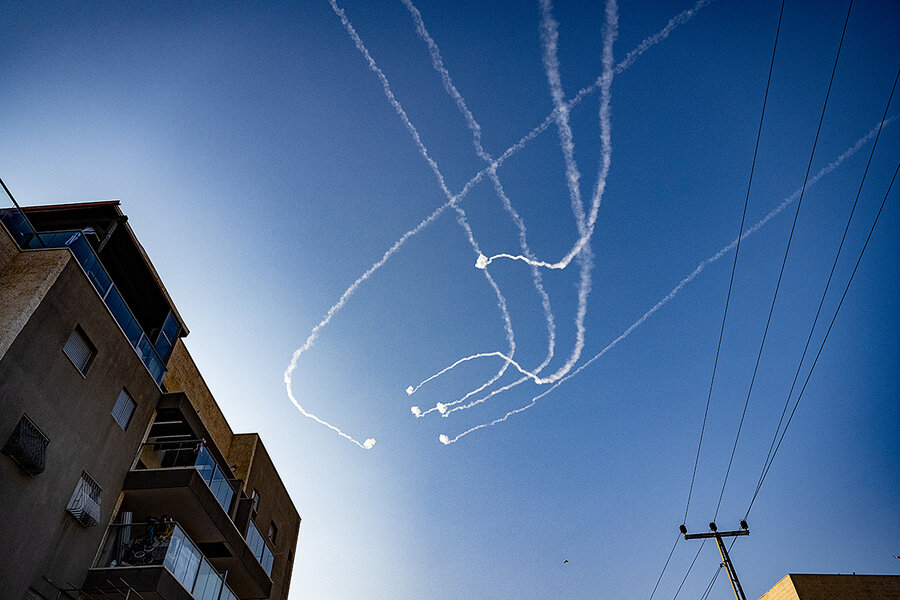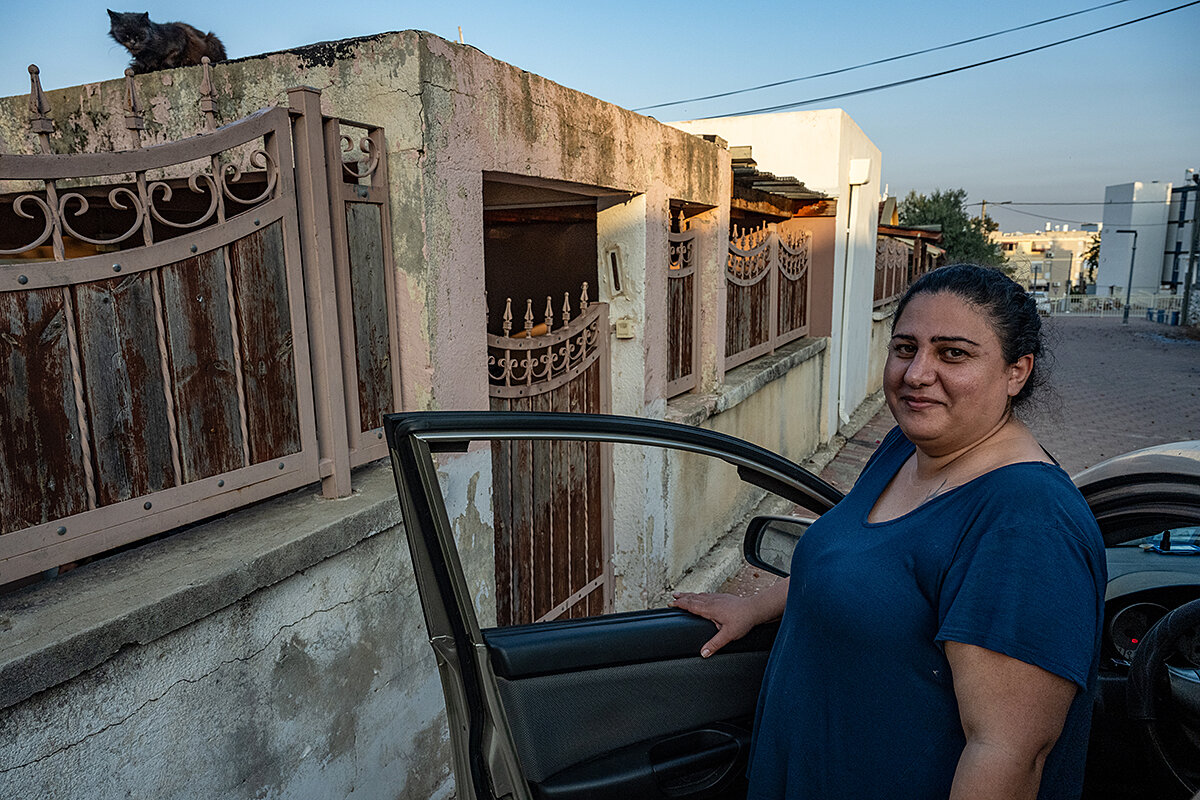In Israeli border town, rockets an audible reminder Hamas is unbeaten
Loading...
| Sderot, Israel
Located barely half a mile from the Gaza Strip, the Israeli town of Sderot has long been in Hamas’ crosshairs. A display case in the municipal offices includes remnants of several Hamas rockets fired over the years.
But despite more than eight weeks of heavy Israeli bombardment of Hamas targets in Gaza, and an intensifying ground incursion, Hamas is proving it can still launch hundreds of rockets into Israel. Regularly, debris rains down on Sderot after missiles of Israel’s Iron Dome air defense system intercept the rockets overhead.
Why We Wrote This
A story focused onFor years the Israeli border town of Sderot has been the target of Hamas rockets. With the town largely emptied since Hamas’ Oct. 7 attack, and rockets still flying despite Israel’s massive offensive, achieving safety appears a long way off.
Today just an estimated 5,000 residents remain out of a prewar population of 36,000.
“They are traumatized. ... They want security,” says Yaron Sasson, the spokesperson for Sderot. “They want to know there is no chance of a single rocket from Gaza.”
A woman who gave the name Diana, who was visiting briefly to care for her cats, says 20 years living in Sderot has meant learning to “live with bombs.” Her home is near a synagogue that was struck by a rocket Sunday.
“We have to be patient,” she says. “This is our home, and we have to fight for it. We [Jews] got this country because we need it, not because we want to push Palestinians out.”
The relentless fire of Israeli artillery provides the noisy soundtrack in this largely emptied front-line Israeli town, its scenes of grassy suburbia located barely a half-mile – as the rocket flies – from the northeast corner of the Gaza Strip.
But despite more than eight weeks of intense Israeli bombardment of Hamas targets in Gaza, and a ground incursion that has left most of the now-decimated northern strip under Israeli control, there is another, parallel soundtrack over Sderot that surprises many here.
Every day Hamas, the Islamist militant group that rules Gaza, proves it can still launch rockets into Israel, with several hundred fired so far since the collapse of a weeklong cease-fire last Friday. And every day, missiles of Israel’s Iron Dome short-range air defense system fly into the air to knock the rockets out with a burst and puff of smoke that rains debris down on Sderot and other Israeli towns.
Why We Wrote This
A story focused onFor years the Israeli border town of Sderot has been the target of Hamas rockets. With the town largely emptied since Hamas’ Oct. 7 attack, and rockets still flying despite Israel’s massive offensive, achieving safety appears a long way off.
“We thought when the IDF [Israel Defense Forces] go to Gaza, and go inside and destroyed terrorists, there is no rockets,” says Yaron Sasson, the spokesperson for Sderot who wears a pistol tucked into his belt. “But they still shoot rockets at Sderot, at Tel Aviv, Ramat Gan, Be’er Sheva, all the area.”
Israel has vowed to “destroy” Hamas after it mounted an attack Oct. 7 that overran more than 20 Israeli communities, leaving 1,200 people dead and 240 taken hostage, Israel says. In Sderot alone, rampaging Hamas fighters killed 50 people that day.
With Israel still reeling from its most traumatic losses since the Jewish state’s founding 75 years ago, politicians and the IDF alike are vowing to permanently remove Hamas as a threat. But continued rocket fire, two months into the war, underscores the challenge of finding and eliminating a potent and carefully hidden arsenal.
“I think we know that we are at the middle of the beginning, and I think we know it’s going to take a long while,” says an IDF reservist major in Sderot, who asked not to be named because he was not authorized to speak to the press. Ultimately, he adds, “a lot is going to depend on the relationship between us and the Palestinians – it’s never going to be the same.”
Indeed, even by the violent high bar set by previous Israel-Hamas flare-ups, the level of destruction in the current conflict is staggering. Israel says it struck more than 14,000 targets in the first month of war alone, and has destroyed 500 of the 800 underground tunnel shafts it has so far discovered.
The result has been the pulverization of swaths of northern Gaza, and the deaths of some 15,900 Palestinians – the majority of them women and children – according to officials of the Hamas-run health ministry. The United Nations and relief agencies warn of a deepening catastrophe for 2.2 million Gaza residents, most now squeezed into the south of the narrow coastal strip.
“Still hundreds” of rockets
But even as Israel now wages what it calls “aggressive” ground operations against the southern city of Khan Yunis, which the IDF says includes some of the fiercest close-quarter combat of the war, Hamas has continued to target Israel with rockets.
“They’re still firing hundreds [of rockets] toward Israel, all over,” an IDF spokesperson, Lt. Col. Richard Hecht, told journalists Tuesday, when asked by the Monitor about post-cease-fire Hamas rocket launches.
“So it’s still hundreds; they still hold that capability. And we are still hunting down that capability,” he said.
Israel is finding “unprecedented” Hamas fortifications embedded in civilian areas, Lieutenant Colonel Hecht said, including schools used for shooting positions against advancing IDF troops. Israeli officials estimate that 5,000 Hamas fighters have been killed out of a prewar force of 30,000, in addition to 1,000 killed in Israel Oct. 7.
But on the eve of the cease-fire, which began Nov. 24, Foreign Minister Hossein Amir-Abdollahian of Iran said Hamas leaders assured him that the Palestinian fighters still had 90% of their “capabilities, forces, and weapons.” Iran has bankrolled Hamas as part of its anti-Israel and anti-Western “Axis of Resistance,” and been instrumental in improving its war readiness.
Some of Hamas’ arsenal has been expended in Sderot, which has been targeted by 400 Hamas rockets since Oct. 7, with 250 of those slipping through Iron Dome defenses, says Mr. Sasson, the town spokesperson. The tempo has decreased, with a handful of rockets each day, but on Sunday a rocket tore through the roof of an empty synagogue.
To “live with bombs”
Located so closely to the border with Gaza, Sderot has long been in Hamas’ crosshairs. A display case in the municipal offices includes remnants of several Hamas rockets fired over the years.
Today Sderot remains largely a ghost town, with estimates of just 5,000 residents remaining out of a prewar population of 36,000. Those who have left – more than 30,000 people – are now spread across the entire country and living in 110 separate hotels.
“They are traumatized. ... They want and they hope that soon they can come back to their homes in Sderot, but they want security,” says Mr. Sasson, speaking as a drone buzzes overhead and Israeli artillery fire disturbs the birds. “They want to know there is no chance of a single rocket from Gaza. They want to know if their child goes to the swimming pool or onto the street, that they will not be injured or killed.”
That standard is far from being met for a woman who gave the name Diana, who says 20 years living in Sderot has meant learning to “live with bombs.” Her low-slung family house is near the synagogue struck Sunday, across a street now strewn with broken glass and red roof tiles. She visited briefly Monday, to care for her cats.
“We have to be patient,” she says. “This is our home, and we have to fight for it. We [Jews] got this country because we need it, not because we want to push Palestinians out.”
But Diana says she is a “realist” and believes coexistence is unlikely with Hamas. “They say, ‘There will come a time when Jews will not be here,’” she says.
Ensuring that that does not happen is the aim of the reservist major, who says the purpose of Israel’s offensive is to allow people to return home, “not to hold people in hotels for the next six months.”
“People who live here don’t want to see a museum of destroyed houses; they want to see life,” says the major. Continued Hamas rocket fire is “exactly why there is no other choice” than a ground offensive.
Ashkelon’s “war routine”
Vying for the title of the most rocketed city in Israel is Ashkelon, just a few miles north of Sderot on the Mediterranean coast. Since Oct. 7, some 1,300 Hamas rockets have been fired at Ashkelon, with 200 of them falling in the city area.
Residents have learned to live with a new “war routine,” says municipal spokesperson Dana Grinblat, adding that it has been an “absolute miracle” that only two people died under rocket fire, considering that 25,000 of its 158,000 residents have no access to bomb shelters.
Ashkelon was targeted by 296 Hamas rockets Oct. 7, with 48 of them landing.
Sirens sounded again Tuesday morning, as a rocket landed on a residential building, wounding two people. It was one of more than 25 Hamas rockets to target Ashkelon since the cease-fire collapsed, nearly all destroyed by Iron Dome.
“It’s a little bit confusing,” says Ms. Grinblat, about how Hamas continues to fire rockets, after so many weeks of Israeli bombardment. But she adds, “It’s nothing like in the first weeks.
“We really hope that, after the war, we won’t need the shelters,” she says. “But I think that may be too optimistic.”











